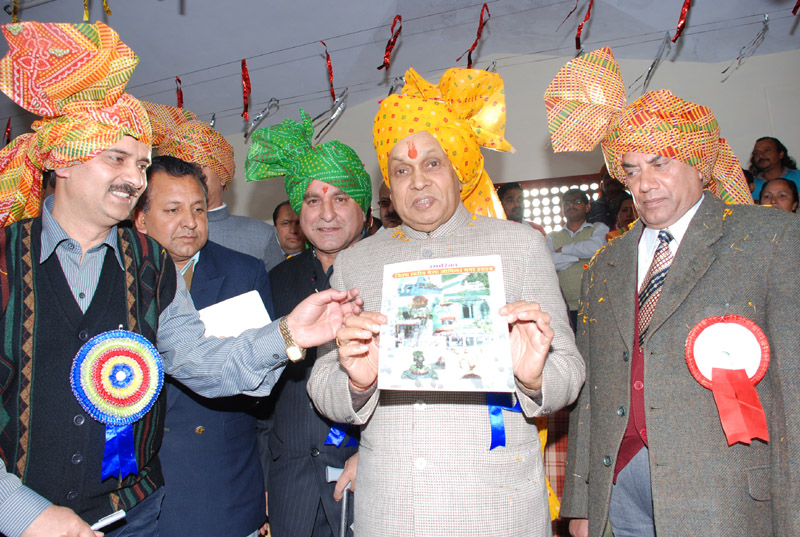Shimla: Rivers in spate, mega hydropower plants having to be shut down at short notice, dams filled to the brim, cloud bursts and road networks having suffered heavy damages; a vigorous monsoon this year has left behind a trail of destruction that has so far cost 30 precious human lives with another 4 missing.
Chief Minister Prem Kumar Dhumal during the August 23-29 monsoon legislative session put the rain damages thus far at Rs 334 Crore in which besides the human lives lost, a total of 1903 houses had been damaged.
He said that the rains which were normal in June, deficient in July had been vigorously active in August. Crop losses have already been to the tune of over Rs 101 crores and damage to private and government property, still counting, has been assessed at Rs 233 crore, he added.
Describing the fury of a cloud burst in Solang valley of Kullu – Manali when gushing waters at midnight hit a labour colony on July 20th and killed 12 people, BM Nanta deputy commissioner recalled, “a portion of a glacier higher up in the valley was broken up by the cloud burst and large chunks ice were found floating all the way down in Beas river. Slush flow was so heavy that it blackened the big river for 2 days. Bodies of four victims killed have not yet been recovered.
A cloudburst is a freak localized climatic phenomenon occurring in the mountains where excessive rains over a short duration falls in a small catchment leading to heavy downstream devastation.
Tourists and commuters to Lahaul-Spiti and Leh who travel on the Manali-Keylong road have been facing frequent disruption of traffic at Rani Nallah, close to Rohtang Pass, where Border Roads Organisation (BRO) are repairing and widening the road.
District administration head Nanta said, “widening work on the Rohtang stretch has been going on for about two years and as the roads happens to be under BRO, the state has to depend upon them for its maintenance and upkeep.â€
The slow pace of work on the road has affected movement of people and goods. With there being no readily available emergency helicopter services, a road breakdown here often results into the whole Lahaul valley getting landlocked as Rohtang Pass is the only access point into the region.
Pilgrims who in August make a beeline for the holy temples of Chintpurni Mata, Brajeshwari Devi, Jwalamukhi, Chamunda Devi, Naina Devi and others around Una, Kangra, Hamirpur and Bilaspur bore the brunt of a heavy round of rains.
On 12th August, torrential rains washed away a pillar of a railway bridge at Chakki, leading to collapse of a span on the Pathankot-Jogindernagar narrow gauge rail line. Rail traffic was suspended.
A record 342 mm of rains within 24 hours recorded on 13th August in Una left many low lying areas of the district inundated. With highway stretches under flood waters and a vital bridge on Una-Amb giving way, much of the traffic was disrupted. The district had not seen such flooding since 1988.
While incessant rains for a whole week pounded the lower hills, it was temporary winter in Lahaul where an unseasonal snowfall, plummeted temperatures sharply and damaged most crops. Keylong, the district headquarters of Lahaul, recorded 5 Cms of unseasonal snow, which was preceded by 55 mm of rain. Higher reaches had 10 to 15 Cms of snow.
In Kangra valley at Dharamshala, the heavy rains peeled off much of the tar layer on the 10 Km Dharamshala-McLeodganj road.
A surging Beas river on August 16 submerged a 300 meter stretch on the Mandi-Kullu highway stranding hundreds of commuters including tourists for hours. Upstream another 400 meter stretch between Kullu and Manli was submerged for over 3 hours disrupting traffic flow.
On the day, 14 persons were reported killed and another nine injured. An adventure motorcyclist travelling from Spiti valley to Lahaul was killed by a rolling boulder at Chota Dhara. A driver of a private bus was buried by a landslide on the Swarghat-Bilaspur highway. A cloudburst at Rangri Nallah on the Manali Kullu road washed away a family of three in their car, burying it completely along a bed of Beas River.
The earthen dam at Pong on Beas got filled to capacity and flood gates are being opened from time to time for release extra flows.
In between rising silt in rivers temporarily forced a shout down all major hydropower plants, causing a sudden outage of over 3000 MW of power that destabilized the northern grid for a while.
As Editor, Ravinder Makhaik leads a team of media professionals at Hill Post.
Spanning a career of over two decades in mass communication, as a Documentary Filmmaker, TV journalist, Print Media journalist and with Online & Social Media, he brings with him a vast experience. He lives in Shimla.


